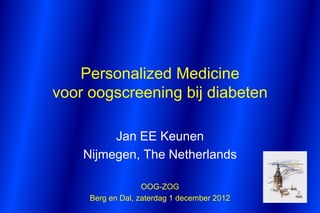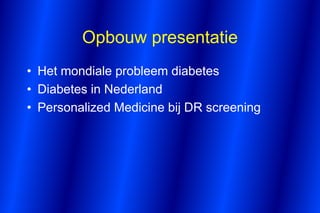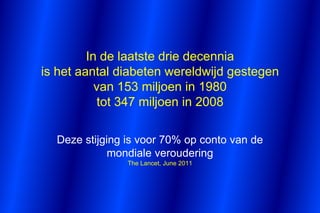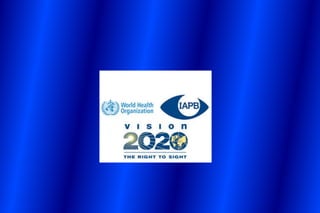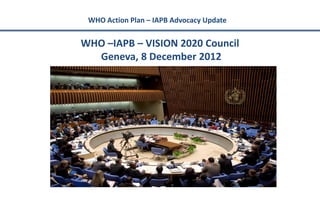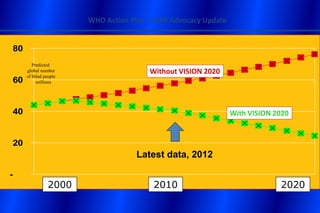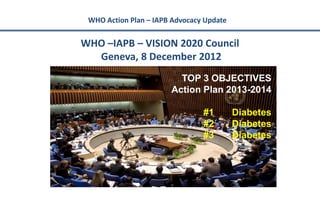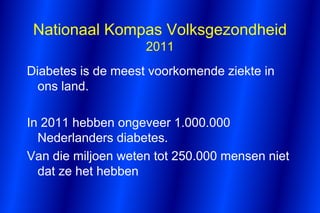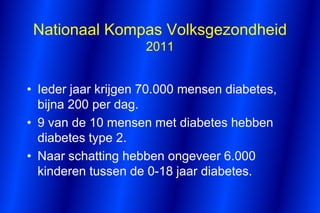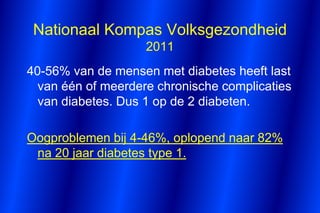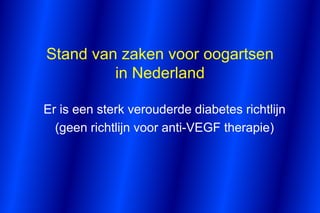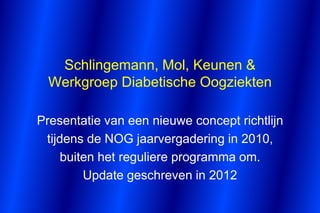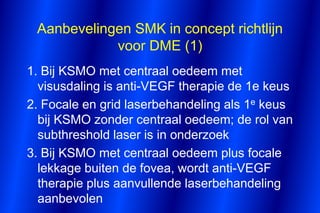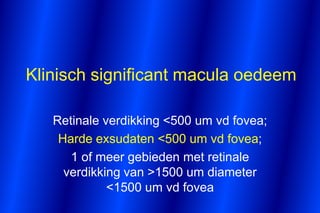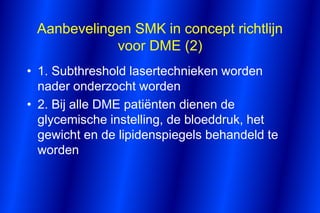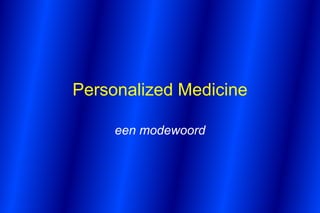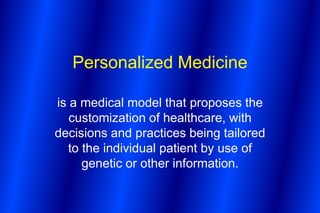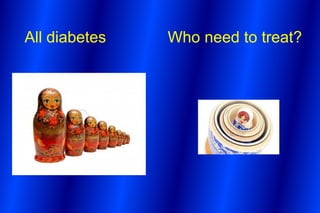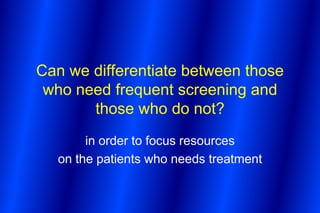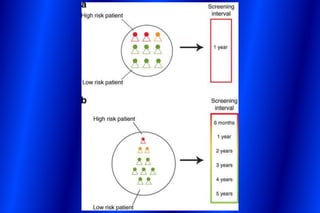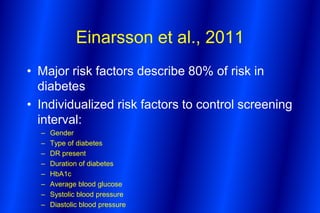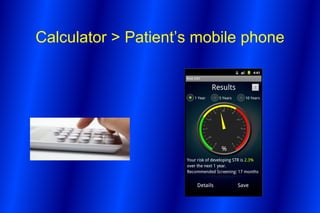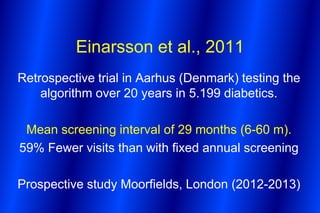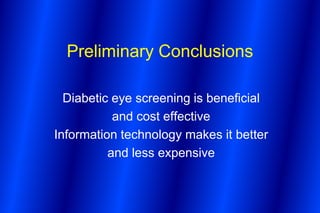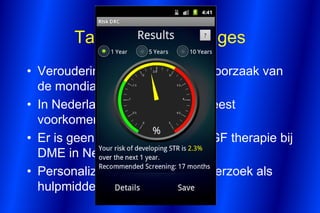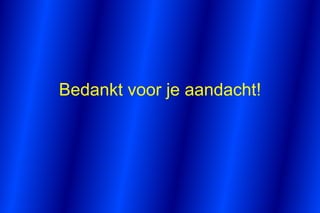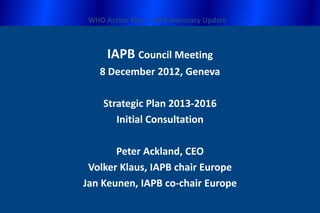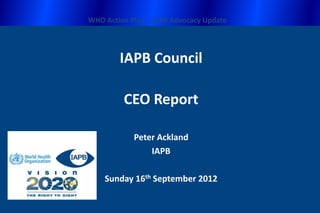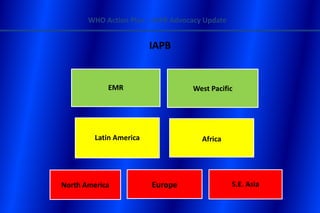OOG/ZOG: Keunen valmonte 2012
- 1. Personalized Medicine voor oogscreening bij diabeten Jan EE Keunen Nijmegen, The Netherlands OOG-ZOG Berg en Dal, zaterdag 1 december 2012
- 2. Opbouw presentatie ŌĆó Het mondiale probleem diabetes ŌĆó Diabetes in Nederland ŌĆó Personalized Medicine bij DR screening
- 3. In de laatste drie decennia is het aantal diabeten wereldwijd gestegen van 153 miljoen in 1980 tot 347 miljoen in 2008 Deze stijging is voor 70% op conto van de mondiale veroudering The Lancet, June 2011
- 5. WHO Action Plan ŌĆō IAPB Advocacy Update WHO ŌĆōIAPB ŌĆō VISION 2020 Council Geneva, 8 December 2012
- 6. WHO Action Plan ŌĆō IAPB Advocacy Update 80 Predicted global number Without VISION 2020 of blind people 60 millions 40 With VISION 2020 20 Latest data, 2012 - 2000 2010 2020
- 7. WHO Action Plan ŌĆō IAPB Advocacy Update WHO ŌĆōIAPB ŌĆō VISION 2020 Council Geneva, 8 December 2012 TOP 3 OBJECTIVES Action Plan 2013-2014 #1 Diabetes #2 Diabetes #3 Diabetes
- 8. Nationaal Kompas Volksgezondheid 2011 Diabetes is de meest voorkomende ziekte in ons land. In 2011 hebben ongeveer 1.000.000 Nederlanders diabetes. Van die miljoen weten tot 250.000 mensen niet dat ze het hebben
- 9. Nationaal Kompas Volksgezondheid 2011 ŌĆó Ieder jaar krijgen 70.000 mensen diabetes, bijna 200 per dag. ŌĆó 9 van de 10 mensen met diabetes hebben diabetes type 2. ŌĆó Naar schatting hebben ongeveer 6.000 kinderen tussen de 0-18 jaar diabetes.
- 10. Nationaal Kompas Volksgezondheid 2011 40-56% van de mensen met diabetes heeft last van ├®├®n of meerdere chronische complicaties van diabetes. Dus 1 op de 2 diabeten. Oogproblemen bij 4-46%, oplopend naar 82% na 20 jaar diabetes type 1.
- 11. Stand van zaken voor oogartsen in Nederland Er is een sterk verouderde diabetes richtlijn (geen richtlijn voor anti-VEGF therapie)
- 12. Schlingemann, Mol, Keunen & Werkgroep Diabetische Oogziekten Presentatie van een nieuwe concept richtlijn tijdens de NOG jaarvergadering in 2010, buiten het reguliere programma om. Update geschreven in 2012
- 13. Aanbevelingen SMK in concept richtlijn voor DME (1) 1. Bij KSMO met centraal oedeem met visusdaling is anti-VEGF therapie de 1e keus 2. Focale en grid laserbehandeling als 1e keus bij KSMO zonder centraal oedeem; de rol van subthreshold laser is in onderzoek 3. Bij KSMO met centraal oedeem plus focale lekkage buiten de fovea, wordt anti-VEGF therapie plus aanvullende laserbehandeling aanbevolen
- 14. Klinisch significant macula oedeem Retinale verdikking <500 um vd fovea; Harde exsudaten <500 um vd fovea; 1 of meer gebieden met retinale verdikking van >1500 um diameter <1500 um vd fovea
- 15. Aanbevelingen SMK in concept richtlijn voor DME (2) ŌĆó 1. Subthreshold lasertechnieken worden nader onderzocht worden ŌĆó 2. Bij alle DME pati├½nten dienen de glycemische instelling, de bloeddruk, het gewicht en de lipidenspiegels behandeld te worden
- 16. Personalized Medicine een modewoord
- 17. Personalized Medicine is a medical model that proposes the customization of healthcare, with decisions and practices being tailored to the individual patient by use of genetic or other information.
- 18. All diabetes Who need to treat?
- 19. Can we differentiate between those who need frequent screening and those who do not? in order to focus resources on the patients who needs treatment
- 20. PM bij oogscreening Individual Risk Assessment for DR screening
- 21. Einarsson et al., 2011 ŌĆó Major risk factors describe 80% of risk in diabetes ŌĆó Individualized risk factors to control screening interval: ŌĆō Gender ŌĆō Type of diabetes ŌĆō DR present ŌĆō Duration of diabetes ŌĆō HbA1c ŌĆō Average blood glucose ŌĆō Systolic blood pressure ŌĆō Diastolic blood pressure
- 22. Calculator > PatientŌĆÖs mobile phone
- 23. Einarsson et al., 2011 Retrospective trial in Aarhus (Denmark) testing the algorithm over 20 years in 5.199 diabetics. Mean screening interval of 29 months (6-60 m). 59% Fewer visits than with fixed annual screening Prospective study Moorfields, London (2012-2013)
- 24. Preliminary Conclusions Diabetic eye screening is beneficial and cost effective Information technology makes it better and less expensive
- 25. Take home messages ŌĆó Veroudering is de belangrijkste oorzaak van de mondiale diabetes epidemie ŌĆó In Nederlands is diabetes de meest voorkomende aandoening ŌĆó Er is geen richtlijn voor anti-VEGF therapie bij DME in Nederland ŌĆó Personalized Medicine is in onderzoek als hulpmiddel bij DR screening
- 26. Bedankt voor je aandacht!
- 27. WHO Action Plan ŌĆō IAPB Advocacy Update IAPB Council Meeting 8 December 2012, Geneva Strategic Plan 2013-2016 Initial Consultation Peter Ackland, CEO Volker Klaus, IAPB chair Europe Jan Keunen, IAPB co-chair Europe
- 28. WHO Action Plan ŌĆō IAPB Advocacy Update IAPB Council CEO Report Peter Ackland IAPB Sunday 16th September 2012
- 29. WHO Action Plan ŌĆō IAPB Advocacy Update IAPB EMR West Pacific Latin America Africa North America Europe S.E. Asia

